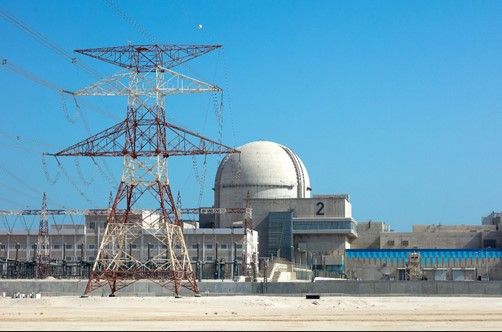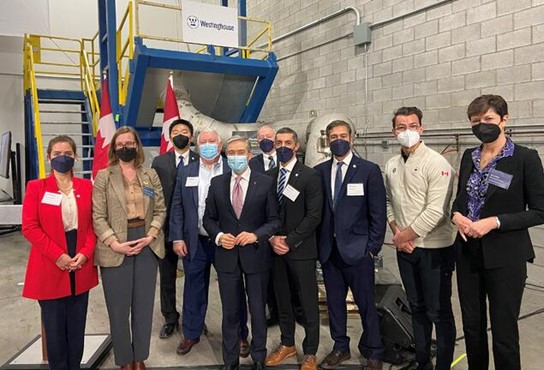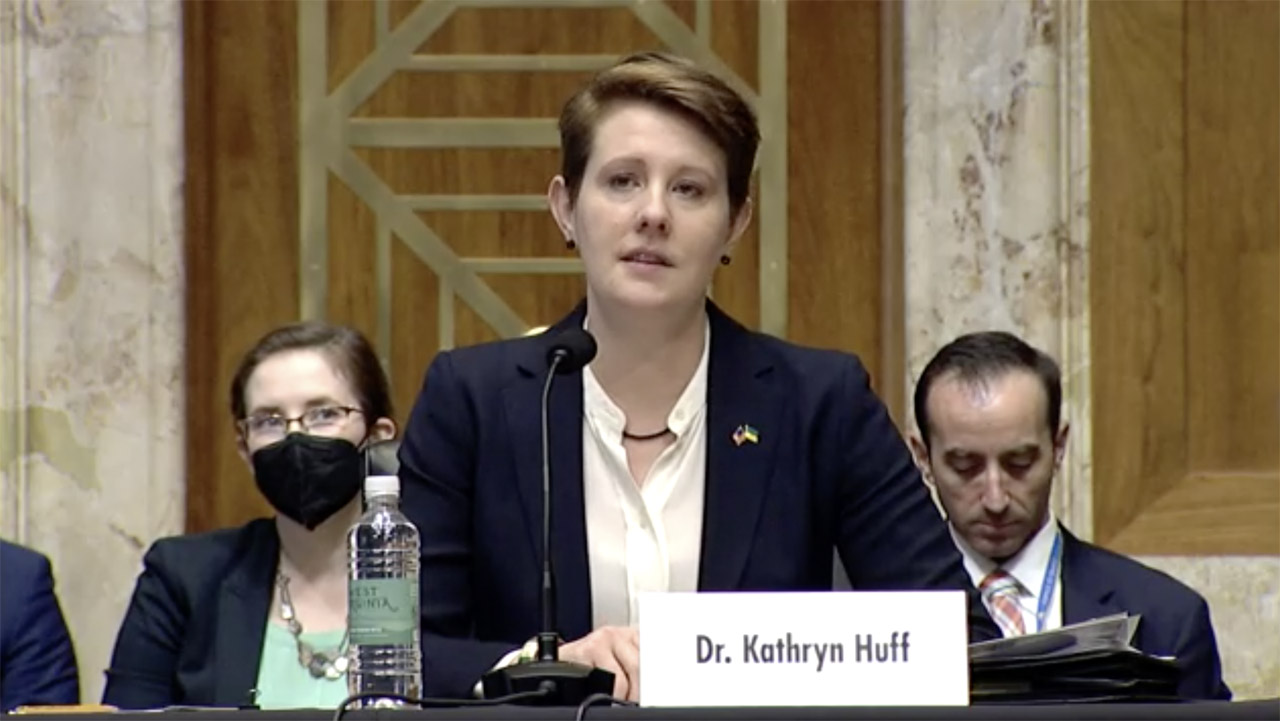U.S. Sen. Joe Manchin (center) tours the ITER site with ITER chief scientist Tim Luce. (Photo: ITER)
“We cannot eliminate our way to net zero,” said Sen. Joe Manchin (D., W.Va.) during a visit to the ITER site in Cadarache, France, on March 25. “We have to innovate, not eliminate, our way to carbon neutrality."
Manchin was joined by Ali Nouri, assistant secretary for congressional and intergovernmental affairs at the Department of Energy; Kathy McCarthy, director of the U.S. ITER Project Office; and other U.S. officials for a tour of the ITER Assembly Hall led by ITER chief scientist Tim Luce, head of the ITER Science and Operations Domain. The visit was described in an ITER Newsline article published on March 28.
The Fuqing nuclear power plant. (Image: CNNC)
The Fuqing nuclear plant’s Unit 6, one of two Chinese-designed and -developed Hualong One reactors at the site, has entered commercial operation, China National Nuclear Corporation (CNNC) announced on March 25. The milestone was reached some 14 months after the reactor’s twin, Fuqing-5, became the first Hualong One in the world to enter commercial operation.
Also known as the HPR1000, the Hualong One is a 1,000-MWe Generation III pressurized water reactor that incorporates design elements of CNNC’s ACP1000 and China General Nuclear Power Group’s ACPR1000+.
Unit 2 at the UAE’s Barakah nuclear plant. (Photo: ENEC)
Unit 2 at the United Arab Emirates’ Barakah nuclear power plant has entered commercial operation, Emirates Nuclear Energy Corporation (ENEC) announced on March 24. Unit 2 adds an additional 1,400 MW of zero-carbon emission electricity to the UAE’s national grid, bringing the total amount of electricity produced at Barakah to 2,800 MW.
U.S. undersecretary of state for arms control and international security Bonnie Jenkins (left) and Philippine energy undersecretary Gerardo D. Erguiza Jr. (center) sign a memorandum of understanding on nuclear cooperation at the State Department. Looking on (right) is Philippine ambassador to the United States Jose Manuel Romualdez. (Photo: Philippine Embassy, Washington, D.C.)
The United States and the Philippines recently signed a memorandum of understanding on strategic civil nuclear cooperation to help boost the development of the latter’s nuclear energy program.
Czech prime minister Petr Fiala and ČEZ CEO Daniel Beneš (foreground, third and fourth from left, respectively). (Photo: ČEZ)
A cutaway image of the BWRX-300. (Image: GEH)
Wilmington, N.C.–based GE Hitachi Nuclear Energy has signed a memorandum of understanding with Kärnfull Next—a new company and a wholly owned subsidiary of Swedish firm Kärnfull Future AB—to collaborate on the deployment of GEH’s BWRX-300 small modular reactor in Sweden.
François-Philippe Champagne, Canada’s minister of innovation, Science, and Industry (center, foreground), visited Westinghouse Electric Canada’s Burlington, Ontario, facility for the March 17 announcement. (Photo: Westinghouse)
The Canadian government has announced an investment of C$27.2 million (about $21.6 million) in Westinghouse Electric Canada to support the development of the company’s eVinci microreactor technology.
François-Philippe Champagne, Canada’s minister of Innovation, Science, and Industry, made the announcement on March 17 during a visit to the company’s Burlington, Ontario, facility.
An aerial view of Finland’s Loviisa plant.
Finnish utility Fortum Power and Heat Oy has submitted an application to Finland’s Ministry of Economic Affairs and Employment to operate the two reactors at the Loviisa nuclear power plant through 2050. The current operating licenses for Loviisa-1 and -2 expire in 2027 and 2030, respectively.
A panel on the status and benefits of fusion technology featured, from left, Kimberly Budil (moderator), of Lawrence Livermore National Laboratory; Kathy McCarthy, of Oak Ridge National Laboratory; Abdalla Darwish, of Dillard University; Anne White, of the Massachusetts Institute of Technology; Steven Cowley, of Princeton Plasma Physics Laboratory; and Mark Berry, of Southern Company.
The White House Office of Science and Technology Policy and the Department of Energy cohosted the White House Summit on Developing a Bold Decadal Vision for Commercial Fusion Energy on March 17. The livestreamed event brought together fusion leaders from government, industry, academia, and other stakeholder groups to showcase recent achievements in fusion research and discuss the administration’s strategy to support the development of commercial fusion energy. Energy Secretary Jennifer Granholm’s announcement of a new agency-wide fusion energy initiative and a funding opportunity worth $50 million for magnetic confinement fusion research made March 17 a lucky day indeed for the U.S. fusion energy community.
The Doel nuclear power plant in Belgium.
In a move motivated by Russia’s invasion of Ukraine and the sky-high energy prices hitting Europe as a result, the Belgian government last Friday announced its intention to extend the operational life of two of its nuclear power reactors, Doel-4 and Tihange-3, through 2035.
The NIST Center for Neutron Research in Gaithersburg, Md. (Photo: NIST)
In the 13 months since a fuel element failure triggered a scram of the research reactor at the National Institute of Standards and Technology’s NIST Center for Neutron Research (NCNR), the event and its causes have been scrutinized by both NIST and the Nuclear Regulatory Commission.
Initial conclusions from an NRC special inspection released on March 16 confirm that while public health and safety was maintained during and after the event, and doses to reactor facility staff were well below regulatory limits, a safety limit was violated when the temperature of the fuel cladding of a single fuel element in the 20-MWt research reactor reached a temperature high enough to partially melt the element.
Europeans are taking resolute steps to reduce their output of climate-changing gases, but some countries are moving in the wrong direction.
Europeans are taking resolute steps to reduce their output of climate-changing gases, but some countries are moving in the wrong direction.
Many countries are adding solar and wind, which are low-carbon energy sources. Some have moved to biomass, the value of which as a climate cure is not clear. A few are adding reactors, while others are defining nuclear as dirty energy and natural gas as “clean” and are changing their generation mix accordingly.
Nominated to lead the DOE’s Office of Nuclear Energy, Kathryn Huff testifies before the Senate Energy and Natural Resources Committee on March 17.
The Senate Energy and Natural Resources Committee met yesterday to consider the nomination of Kathryn Huff to head the Department of Energy’s Office of Nuclear Energy (NE). President Biden selected Huff to fill the top spot at NE in January.










.jpg)







